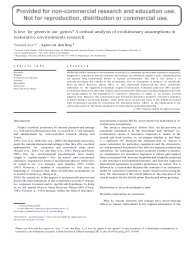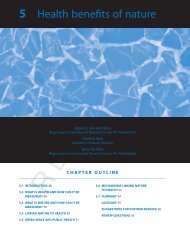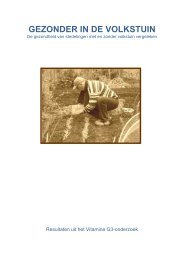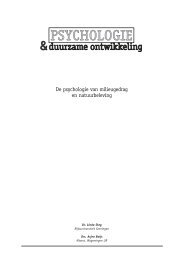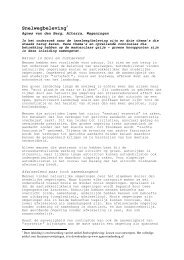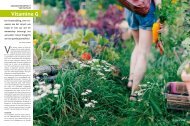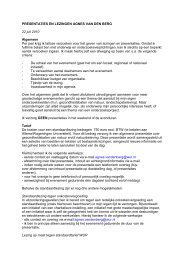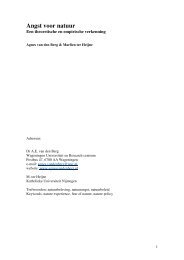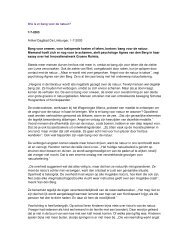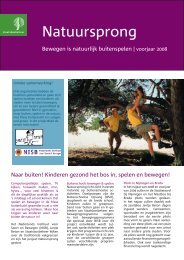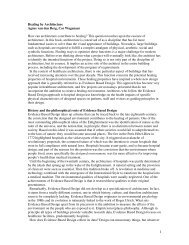New wilderness in the Netherlands - Agnes van den Berg
New wilderness in the Netherlands - Agnes van den Berg
New wilderness in the Netherlands - Agnes van den Berg
Create successful ePaper yourself
Turn your PDF publications into a flip-book with our unique Google optimized e-Paper software.
366 A.E. Van <strong>den</strong> <strong>Berg</strong>, S.L. Koole / Landscape and Urban Plann<strong>in</strong>g 78 (2006) 362–372time of survey, several plan alternatives had been formulated andmade public. A preferred alternative had not yet been selected.2.3. StimuliThe stimulus set consisted of six pairs of full-color photographs(10 cm × 15 cm) of natural landscapes. The photographswere selected <strong>in</strong> consultation with local authorities(Fig. 1). One photograph of each pair depicted <strong>the</strong> landscape <strong>in</strong><strong>the</strong> area as it would look like after <strong>the</strong> realization of active naturemanagement strategies (i.e., landscapes classified as ‘sem<strong>in</strong>atural’or ‘multifunctional’ <strong>in</strong> <strong>the</strong> Dutch handbook of targetnature types; Bal et al., 1996). The o<strong>the</strong>r photograph of eachpair depicted <strong>the</strong> landscape <strong>in</strong> <strong>the</strong> area as it would look like whenit would be left to evolve spontaneously, without active human<strong>in</strong>tervention (i.e., landscapes classified as ‘approximately natural’or ‘guided natural’ <strong>in</strong> <strong>the</strong> handbook of target nature types).Because examples of <strong>the</strong> latter type of landscape were not available<strong>in</strong> The Ne<strong>the</strong>rlands at <strong>the</strong> time of study, our contact persons<strong>in</strong> <strong>the</strong> areas selected referent images from o<strong>the</strong>r countries, suchas Poland and Russia, to portray this type of landscape.In <strong>the</strong> questionnaire, <strong>the</strong> two types of nature developmentlandscapes were referred to as landscapes A and B. In <strong>the</strong> <strong>in</strong>troduction,it was expla<strong>in</strong>ed that <strong>the</strong> landscapes <strong>in</strong>dicated with an Arepresented ‘actively’ managed sett<strong>in</strong>gs, while landscapes <strong>in</strong>dicatedwith a B represented ‘passively’ managed sett<strong>in</strong>gs. Theconcepts of active and passive management were expla<strong>in</strong>ed <strong>in</strong>a neutral manner, without emphasiz<strong>in</strong>g <strong>the</strong> desirability of a particularstrategy (see Appendix A).2.4. Measures and questionnaireThe questionnaire began with a general <strong>in</strong>troduction, <strong>in</strong> whichrespon<strong>den</strong>ts were given a map depict<strong>in</strong>g <strong>the</strong> locations of <strong>the</strong>six plan areas and some basic <strong>in</strong>formation on nature developmentand nature management strategies (see Appendix A). Therema<strong>in</strong>der of <strong>the</strong> questionnaire was divided <strong>in</strong>to three parts. Thefirst part started with questions about <strong>the</strong> 12 photographs ofnatural sett<strong>in</strong>gs. Pairs of photographs of actively and passivelymanaged landscapes were shown <strong>in</strong> <strong>the</strong> upper halves of adjacentpages, with actively managed landscape on <strong>the</strong> left page,and <strong>the</strong> passively managed landscape on <strong>the</strong> right page. Rat<strong>in</strong>gscales were pr<strong>in</strong>ted directly underneath each photograph.Respon<strong>den</strong>ts were asked to rate each landscape on several characteristics,<strong>in</strong>clud<strong>in</strong>g beauty and perceived <strong>wilderness</strong>.Perceived beauty was measured on a positively skewed, 6-po<strong>in</strong>t Likert scale with separate verbal labels for each scale po<strong>in</strong>t(1 = ‘not at all beautiful’; 2 = ‘not beautiful’; 3 = ‘somewhatbeautiful’; 4 = ‘beautiful’; 5 = ’very beautiful’; 6 = ‘extremelybeautiful’). We decided to use a positively skewed scale, becauseprevious research has shown that natural landscapes generallyelicit positive reactions and are rarely rated as ugly (cf. Ulrich,1993). Perceived <strong>wilderness</strong> was measured by ask<strong>in</strong>g <strong>the</strong> respon<strong>den</strong>tsto rate, on a 5-po<strong>in</strong>t Likert scale, <strong>the</strong> applicability of <strong>the</strong>description: ‘a wild landscape where nature can take its owncourse’. To avoid response bias, <strong>the</strong> question about perceived<strong>wilderness</strong> was embedded <strong>in</strong> a list of eight questions, seven ofwhich are irrele<strong>van</strong>t to <strong>the</strong> focus of <strong>the</strong> present <strong>in</strong>vestigation andwill not be fur<strong>the</strong>r discussed.The second part of <strong>the</strong> questionnaire consisted of generalquestions about nature and landscape, <strong>in</strong>clud<strong>in</strong>g questions aboutrecreational motives. These motives were assessed by ask<strong>in</strong>g<strong>the</strong> respon<strong>den</strong>ts to rate <strong>the</strong> applicability of reasons for visit<strong>in</strong>gnatural areas on a 5-po<strong>in</strong>t scale. The first recreational motive,recovery from stress, was measured by <strong>the</strong> statement: “I visitnature to escape <strong>the</strong> stress of daily life and to put my worriesaside”. The second motive, reflection, was measured by <strong>the</strong> statement“I visit nature to th<strong>in</strong>k <strong>in</strong> peace about <strong>the</strong> th<strong>in</strong>gs that bo<strong>the</strong>rme”. The third motive, study<strong>in</strong>g nature, was measured by <strong>the</strong>statement “I visit nature to study special animals and plants”.These three statements about recreational motives were embeddedamong three o<strong>the</strong>r statements which are irrele<strong>van</strong>t to <strong>the</strong>focus of <strong>the</strong> present <strong>in</strong>vestigation and will not be fur<strong>the</strong>r discussed.The f<strong>in</strong>al part of <strong>the</strong> questionnaire assessed various backgroundcharacteristics, <strong>in</strong>clud<strong>in</strong>g age, <strong>in</strong>come, education level,farm<strong>in</strong>g background, and environmentalism. Respon<strong>den</strong>ts who<strong>in</strong>dicated that <strong>the</strong>y, or <strong>the</strong>ir partner, worked, or had worked, oncattle and/or arable farms were classified as farmers. A measureof environmentalism was derived from respon<strong>den</strong>ts’ politicalpreference. Respon<strong>den</strong>t who <strong>in</strong>dicated that <strong>the</strong>y voted for a‘green’ political party (i.e., “Groen L<strong>in</strong>ks”) dur<strong>in</strong>g <strong>the</strong> last electionswere classified as environmentalists.2.5. Data analysisThe questionnaires of 40 respon<strong>den</strong>ts conta<strong>in</strong>ed one or twomiss<strong>in</strong>g values on rele<strong>van</strong>t variables. Because <strong>the</strong> questionnairewas quite extensive, we suspected that <strong>the</strong>se miss<strong>in</strong>g datareflected random omissions ra<strong>the</strong>r than systematic response patterns.Therefore, to avoid <strong>the</strong> omission of valid data, we decidedto impute <strong>the</strong> miss<strong>in</strong>g data for <strong>the</strong>se respon<strong>den</strong>ts <strong>in</strong>stead of delet<strong>in</strong>g<strong>the</strong>ir data altoge<strong>the</strong>r. We replaced <strong>the</strong> miss<strong>in</strong>g values by <strong>the</strong>average values of <strong>the</strong> o<strong>the</strong>r respon<strong>den</strong>ts. The same pattern ofresults was obta<strong>in</strong>ed when cases with miss<strong>in</strong>g data were deletedfrom <strong>the</strong> dataset (Van <strong>den</strong> <strong>Berg</strong>, 1999).We analyzed <strong>the</strong> data us<strong>in</strong>g analysis of variance (ANOVA)and regression analysis. These statistical techniques assume<strong>in</strong>terval data, while <strong>the</strong> ma<strong>in</strong> depen<strong>den</strong>t variable, perceivedbeauty, was measured on an ord<strong>in</strong>al Likert scale. However,accord<strong>in</strong>g to prevail<strong>in</strong>g notions, Likert scales can be used with<strong>in</strong>terval procedures, provided <strong>the</strong> scale items have at least fiveand preferably seven categories. Perceived beauty had six categories,and thus fulfilled this requirement. Jaccard and Wan(1996) state that for many statistical tests, even ra<strong>the</strong>r severedepartures from <strong>in</strong>tervalness do not seem to affect Type I andType II errors dramatically. This is supported by o<strong>the</strong>r literature(B<strong>in</strong>der, 1984; Nunnally, 1978; Zumbo and Zimmerman, 1993).To prepare <strong>the</strong> data for regression analysis, we first computeddifference scores between beauty rat<strong>in</strong>gs for wild andmanaged landscapes, <strong>in</strong> such a way that higher scores representedhigher relative preferences for wild nature. Notably,<strong>the</strong> use of this s<strong>in</strong>gle preference <strong>in</strong>dex potentially results <strong>in</strong>a loss of <strong>in</strong>formation because it neglects cont<strong>in</strong>uous varia-



